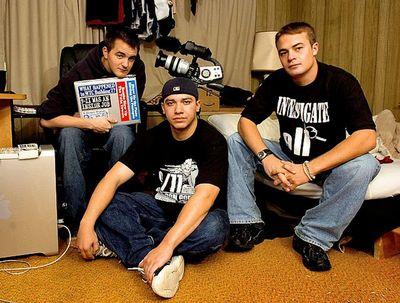
Loose Change 911 Creators: Korey Rowe, Dylan Avery, Jason Bermas
On Friday, Paul Greengrass' film United 93 opens nationwide, telling a story of bravery that this country has embraced because of the comfort it provides in the face of intense pain. On September 11, 2001, passengers on that plane stormed the cockpit and foiled a terrorist plot, in the process sacrificing themselves. The plane was headed for the White House or the United States Capitol, the story goes, but because of the passengers' heroism, it crashed in a field in Pennsylvania.
In August, Oliver Stone's World Trade Center will be released. Its poster promises: "A true story of courage and survival."
And on the Internet, Dylan Avery's Loose Change is available for free. Avery, who is in his early 20s, has made a movie on his laptop that's decidedly less comforting. A dense 82 minutes long, Loose Change argues compellingly that the official history of the September 11 attacks - the story reinforced by mainstream-media works such as Greengrass' - is at best incomplete, and at worst a fabrication.
"The government isn't always telling the truth," said Korey Rowe, the executive producer of Loose Change, in a phone interview this week.
Avery's movie, now in its "second edition," is hardly perfect, with little attention paid to his sources' credibility and a maddening tendency to make unsupported claims of fact, but it's an excellent primer on the "9/11 truth" movement - an umbrella label that encompasses a wide range of conspiracy theories that don't necessarily jibe with one another. Different theories suggest different motives, but at heart all suggest that the Bush administration was culpable in what happened on September 11, either through incompetence or an active agenda.
It's easy for many people to scoff at these theories - especially when some of them blame Jews or psychiatrists for the attacks. Earlier this month, San Francisco Chronicle columnist Cinnamon Stillwell did just that in attacking those who believe any of the various conspiracy theories: "Whatever one's criticisms of the [Bush] administration and its approach to the war on terrorism, one would have to be awfully cynical to believe that it would kill or allow thousands (at the least) of Americans to die, simply to accumulate additional powers." (The column can be found at (http://sfgate.com/cgi-bin/article.cgi?file=/gate/archive/2006/04/19/cstillwell.DTL.)
Even well-intentioned attempts to argue with doubters through facts can be misguided. In introducing the March 2005 article "9/11: Debunking the Myths" (http://www.popularmechanics.com/science/defense/1227842.html?page=1), the editors of Popular Mechanics accused conspiracy theorists of going too far: "Healthy skepticism, it seems, has curdled into paranoia. ... In the end, we were able to debunk each of these assertions with hard evidence and a healthy dose of common sense. We learned that a few theories are based on something as innocent as a reporting error on that chaotic day. Others are the byproducts of cynical imaginations that aim to inject suspicion and animosity into public debate. Only by confronting such poisonous claims with irrefutable facts can we understand what really happened on a day that is forever seared into world history."
What both these articles ignore is the reason behind the conspiracy theories. Fundamentally these theories speak to a distrust of the government line, a questioning of what we've been told to believe and of the purity of government motivations. Even if you don't subscribe to any of these alternative histories, it's important to at least consider them and what they say about our relationship with the government. It's an exercise both in empathy and critical thinking.
As the makers of Loose Change say on the movie's Web site (http://www.loosechange911.com): "Take nothing we say at face value. We highly encourage you to research this information yourselves and come to your own conclusions."
Rowe was even more emphatic. "Please, prove me wrong," he said. "I had a happy life before this."
Secrecy Sparks Suspicion
In its March 27, 2006, issue, New York magazine published the essay "The Ground Zero Grassy Knoll" by Mark Jacobson. (It can be found at (http://www.nymag.com/news/features/16464/index.html.) The article is impressive in being evenhanded, skeptical about the official history of 9/11 and genuinely curious about these myriad alternative theories. Jacobson is wary of the official line but understands that not all these conspiracy theories can be correct.
The article does not sanction or discredit any particular perspective. Its agenda is more nuanced. Comparing September 11 to the assassination of John F. Kennedy, Jacobson implies that the report by the 9/11 Commission will one day be as disregarded in the public mind as the Warren Commission's account. "Four decades after Dallas, it is difficult to find anyone who believes Lee Harvey Oswald was the lone gunman," Jacobson writes.
The author classifies 9/11 stories into four categories: "The Official Story," "The Incompetence Theory," "Let It Happen on Purpose," and "Made It Happen on Purpose." He interviewed reasonable people - these are not your tin-foil-hat types - and recounts when they started to question the government version of events.
What leaps out from the article is a statement by Monica Gabrielle, whose husband died in the attacks. In talking about conspiracy theories, she said, "That's what happens when the truth is systematically suppressed."
Another 9/11 widow said: "I feel like I'm trapped in a truth vacuum."
Loose Change makes a similar point. In asking whether a missile (rather than a plane) hit the Pentagon, the movie notes that surveillance videos from three locations should definitively answer that question. But the federal government has only released a few frames of one of the videos, and they're inconclusive.
Therein lies a critical point: Secrecy sparks suspicion. And that suspicion is fueled by the volume of raw materials available, particularly video and photographic evidence.
And those things, paired with the Internet, represent a combustible combination, as Loose Change proves. The movie has been downloaded more than 4 million times on Google Video, Rowe said, and a "third edition" is planned for theatrical release on September 11, 2006. Rowe said he hopes to lease 300 movie theatres across the nation.
Stranger Than Fiction
Loose Change is an unfortunate title for a movie that's as focused and determined as this one. The name might work better with a typically digression-filled and lazy Michael Moore picture.
The film, which can be viewed at (http://video.google.com/videoplay?docid=-8260059923762628848), is a homemade work, done on a laptop, Rowe said. The two editions so far have cost the filmmakers less than $8,500.
It started off as a fiction screenplay that Avery began writing in summer 2002, Rowe said. The idea was that the protagonists discovered that the government version of the September 11 story was untrue.
But the more research Avery did, the less it seemed like fiction. And Loose Change the documentary was born.
After the first edition was completed, Rowe said, the filmmakers scrapped all but the best 30 minutes and built on it for the second version. That same process is being undertaken for the third edition, which will incorporate actual interviews instead of only secondhand research materials.
The gist of Loose Change is that three World Trade Center buildings were felled by controlled demolition, not by damage caused by the planes that were flown into two of them; that the Pentagon was more likely struck by a missile than a plane; and that no plane crashed at the United 93 crash site in Pennsylvania.
Loose Change taps into a reservoir of uncertainty and clearly lays out a chain of evidence and events - an at least theoretically possible alternative to the official story. The documentary is lucid and economical, and even if you don't buy its conclusions, Loose Change is an effective work in its constant attacking of the official version of events.
What distinguishes the movie more than anything is the way its prologue powerfully sets the tone of the movie, and gives it plausibility.
Loose Change opens with a description Operation Northwoods, a rejected strategy from 1962 that only came to light 39 years later. ABC News described it this way: "The plans reportedly included the possible assassination of Cuban émigrés, sinking boats of Cuban refugees on the high seas, hijacking planes, blowing up a U.S. ship, and even orchestrating violent terrorism in U.S. cities.
"The plans were developed as ways to trick the American public and the international community into supporting a war to oust Cuba's then new leader, communist Fidel Castro."
Fake terrorism as a pretext for military action against a hated despot? It sounds awfully familiar ... .
Of course, less than two years after 9/11, the United States invaded Iraq. As the Washington Post put it in 2004, "President Bush, Vice President Cheney, and other top administration officials have often asserted that there were extensive ties between [Saddam] Hussein's government and Osama bin Laden's terrorist network."
Yet: "The September 11 Commission ... found no 'collaborative relationship' between Iraq and al Qaeda, challenging one of the Bush administration's main justifications for the war in Iraq."
But Loose Change doesn't stop with Operation Northwoods. It then quotes the September 2000 report "Rebuilding America's Defenses" from the conservative think tank The Project for the New American Century. In arguing for increased military spending, the report states: "The process of transformation, even if it brings revolutionary change, is likely to be a long one, absent some catastrophic and catalyzing event - like a new Pearl Harbor." ("Rebuilding America's Defenses" can be found at (http://newamericancentury.org/RebuildingAmericasDefenses.pdf.)
This chilling introduction undermines Stillwell's argument that the government wouldn't kill thousands of its own citizens in a power grab. It first establishes that means shockingly similar to 9/11 were already considered by the federal government in relation to Cuba. Then it offers two related motives: the ouster of Saddam Hussein and increased defense spending.
The pairing is brilliant movie-making, and even if every other claim in the film is hooey, Operation Northwoods lingers as a reminder of what the government is capable of, and the dual agendas serve as motivation for action. Yes, Robert McNamara rejected Operation Northwoods back in the 1962, but the fact that it came from the Joint Chiefs of Staff and made its way to the Secretary of Defense suggest it was seriously considered.
Who's More Right?
Still, it's not hard to pick apart Loose Change detail by detail.
Most commonly, although Avery shows materials ranging from newspaper articles to government documents to Wikipedia as evidence, he doesn't thoroughly cite his sources, and he doesn't offer corroboration. A claim that Osama bin Laden received medical attention in July 2001 at American Hospital Dubai - and was even interviewed at that time by the CIA - is presented as undisputed fact but remains unsupported.
Avery might indeed be correct. Other outlets have repeated the story, such as the Centre for Research on Globalisation at (http://www.globalresearch.ca/articles/RIC111B.html). The CIA, in an article by United Press International (http://www.newsmax.com/archives/articles/2001/10/31/163622.shtml) either denied that bin Laden was in that hospital or denied that an agent visited him there. (The phrasing makes the denial unclear.)
Without multiple sources for each assertion - and without acknowledging or addressing official denials - the movie will not convince many skeptics. Loose Change rushes headlong through its narrative, more concerned with connecting the dots than in persuading people.
Often, Loose Change's lapses are fundamental and glaring but could easily be corrected.
The movie states: "It is scientifically impossible that 12 tons of steel and titanium was vaporized by kerosene." It's a bold claim, and you'll have to take the filmmaker's word on it.
The movie also claims that if the plane that hit the Pentagon was vaporized, it would be the first time in aviation history that a plane crash left no sizable wreckage. Avery then shows as evidence one plane crash.
When Avery notes that the World Trade Center buildings that collapsed did so at a speed similar to an object in free fall, he doesn't have a physicist explain whether that could happen in a circumstance outside of controlled demolition.
Beyond that, Avery offers startling statements without a context in which to understand their importance. He notes, for instance, that the number of "put options" on United Airlines, American Airlines, and Boeing stock on specific days in the week before the September 11 attack was several times more than the daily average. A put option, the movie states, "is a bet that a stock will fall." The implication is that somebody knew the attack was coming, knew some specifics about it, and bought put options to profit from it.
What the movie doesn't provide is evidence that the deviation is significant. It sounds impressive, but if the number of put options fluctuates wildly, the numbers Avery cites could well be within the range of normal, if not anywhere close to "average."
The 9/11 Commission noted that "some unusual trading did in fact occur," but that's irrelevant, because Avery doesn't cite the commission. More importantly, he doesn't provide enough context to understand whether his information is possibly within the realm of normal activity.
Rowe conceded that he and his partners are constantly working to improve the movie, and their case. "There are inconsistencies in our evidence," he admitted. But "we're more right than the 9/11 Commission."










